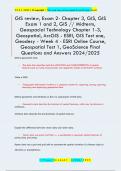2 0 2 4 /2025 | © copyright | This work may not be copied for profit gain Excel!
GIS review, Exam 2- Chapter 3, GIS, GIS
Exam 1 and 2, GIS // Midterm,
Geospacial Technology Chapter 1-3,
Geospatial, ArcGIS - ESRI, GIS Test one,
Geodesy - Week 4 - ESRI Online Course,
Geospatial Test 1, GeoScience Final
Questions and Answers 2024/2025
Define geospatial data.
The data that describes both the LOCATION and CHARACTERISTICS of spatial
features (such as roads, land parcels, and vegetation stands on the Earth's surface.)
What is GIS?
Geographic Information Systems is a computer system for capturing, storing, querying,
analyzing and displaying geospatial data.
Define geometries and attributes as the two components of GIS data.
Geometric data describe the locations of spatial features, which may be discrete or
continuous.
Attribute data describe the characteristics of spatial features.
Explain the difference between vector data and raster data.
Vector data use points and their x-, y-coordinates to represent spatial features of
points, lines, and areas.
Raster data use a grid and grid cells to represent the spatial variation of a feature (such as
elevation or precipitation.)
1|Page| GradeA+ | 2 0 0 2 5
,2 0 2 4 /2025 | © copyright | This work may not be copied for profit gain Excel!
Vector Data Model: Explain the difference between the georelational data model and the
object-based data model.
The georelational data model uses a split system to store spatial data and attribute
data.
The object-based data model stores spatial data and attribute data in a single system.
Name two tools or techniques for vector data analysis.
Tools for vector data analysis include buffering, overlay, distance measurement,
spatial statistics, and map manipulation.
raster data analysis.
includes local, neighborhood, zonal, and global operations.
What is Topology?
It expresses the spatial relationships between features,
What is TIN?
Triangulated Irregular Network.
Describe the 3 levels of approximation of the shape and size of the Earth
for GIS applications.
SPHERE, SPHEROID/ELLIPSOID, GEOID
What is datum?
1|Page| GradeA+ | 2 0 0 2 5
,2 0 2 4 /2025 | © copyright | This work may not be copied for profit gain Excel!
A mathematical model of the Earth, which serves as the reference base for calculating
the geographic coordinates of a location.
Define Projection.
The process of transforming from a geographic coordinate system to a projected
coordinate system. Can also be reprojected onto another coordinate system.
Define Relational Database.
A collection of tables in which tables are connected by keys.
Define Geographic coordinate system.
The location reference system for spatial features on the Earth's surface using latitude
and longitude.
Explain the importance of map projection.
First, a map projection allows us to use 2 dimensional maps, either paper or digital,
instead of a globe. Second, a map projection allows us to work with plane or
projected coordinates rather than longitude and latitude values. Computations with
geographic coordinates are more complex and
yield less accurate distance measurements.
Describe the 4 types of map projections by the preserved property.
A Conformal projection preserves local angles and shapes.
An Equivalent projection represents areas in correct relative size.
An Equidistant projection maintains consistency of scale along certain lines.
An Azimuthal projection retains certain
accurate directions.
1|Page| GradeA+ | 2 0 0 2 5
, 2 0 2 4 /2025 | © copyright | This work may not be copied for profit gain Excel!
Describe the 3 types of map projections by the projection or developable surface.
A cylindrical projection uses a cylinder as the projection or developable surface
A conic projection uses a cone
An azimuthal projection uses a plane.
Explain the difference between the standard line and the central line.
A standard line refers to the line of tangency between the projection surface and the
reference globe. In other words, there is no projection distortion along a standard line.
The central lines (i.e., the central parallel and meridian) define the center of a map projection.
How is the scale factor related to the principal scale?
The scale factor is defined as the ratio of the local scale to the principal scale. In other
words, the scale factor is the normalized local scale. Will be 1 along the standard line
and more distorted away from the line.
Name two commonly used projected coordinate systems that are based on the
transverse Mercator projection.
Universal Transverse Mercator (UTM) grid system State Plane Coordinate (SPC)
system.
Explain how a UTM zone is defined in terms of its central meridian, standard meridian, and
scale factor.
A UTM zone is mapped onto a secant case transverse Mercator projection, with a
scale factor of 0.9996 at the central meridian. The standard meridians are 180
kilometers to the east and west of the central meridian.
Explain the UTM coordinate system
1|Page| GradeA+ | 2 0 0 2 5





